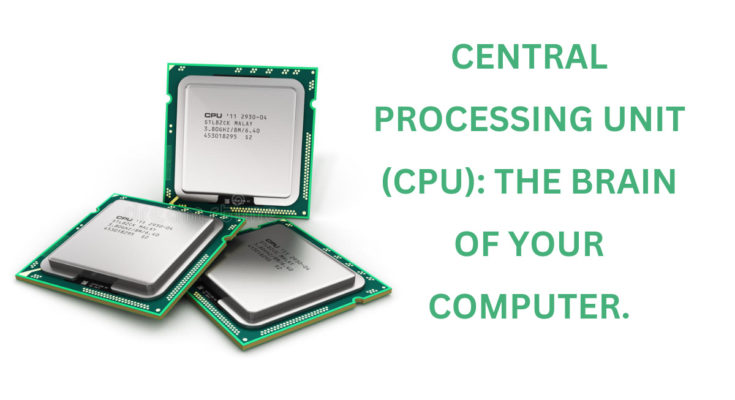A Central Processing Unit (CPU) is the primary component of a computer system that performs the majority of the processing of data and instructions. It is often referred to as the “brain” of the computer.
The CPU is responsible for executing instructions stored in the computer’s memory. It fetches instructions from memory, decodes them, performs the necessary operations, and stores the results back in memory. The CPU is also responsible for controlling the flow of data between the computer’s various components, including the input/output devices, memory, and other subsystems.
Modern CPUs are highly complex and consist of multiple processing cores, cache memory, and various other features designed to increase their performance and efficiency. CPUs are typically manufactured by companies such as Intel, AMD, and ARM, and are found in a wide range of devices, including personal computers, smartphones, tablets, and embedded systems.
CPU : the brain of your computer
The CPU can be considered the “brain” of a computer, as it is responsible for carrying out the majority of the processing of data and instructions that are necessary for the computer to function. The CPU is essentially the control center of the computer, and it performs all of the calculations and operations that are necessary to execute programs, run applications, and perform other tasks. Without a CPU, a computer would not be able to function at all.
FUNCTIONS:-
The CPU (Central Processing Unit) is the brain of a computer, responsible for executing instructions and performing calculations. Some of the key functions of a CPU include:
1. Fetching: The CPU retrieves instructions from memory.
2. Decoding: The CPU interprets the instructions and determines what operation needs to be performed.
3. Execution: The CPU performs the operation indicated by the instruction.
4. Memory access: The CPU reads or writes data from or to memory.
5. Interrupt handling: The CPU can respond to interrupts from hardware devices or software to handle events or perform tasks.
6. Arithmetic and logic operations: The CPU performs mathematical calculations and logical operations, such as addition, subtraction, multiplication, division, comparisons, and bitwise operations.
7. Branching and looping: The CPU can change the order of instructions based on conditional statements or loop instructions, enabling it to perform repetitive tasks or make decisions based on input.
8. Control unit operations: The CPU’s control unit manages the flow of instructions and data within the CPU and between the CPU and other components of the computer system.
These are some of the primary functions of a CPU, but the specific capabilities and features of a CPU can vary depending on its architecture, design, and intended use.
TYPES:-
There are several types of CPUs available in the market, each with its own set of features, capabilities, and specifications. Here are some of the main types of CPUs:
1. Desktop CPUs: These are high-performance CPUs designed for use in desktop computers. They typically have multiple cores and high clock speeds, which allow them to handle demanding applications and multitasking.
2. Laptop CPUs: These CPUs are similar to desktop CPUs, but are designed to be more power-efficient to help extend battery life. They are commonly used in laptops, netbooks, and other portable devices.
3. Server CPUs: These are high-performance CPUs designed for use in servers, which are used to host websites, run applications, and perform other tasks. They typically have multiple cores, large caches, and support for multi-threading.
4. Mobile CPUs: These CPUs are designed for use in smartphones and tablets. They are low-power, energy-efficient processors that are optimized for running mobile apps and other tasks.
5. Embedded CPUs: These CPUs are designed for use in embedded systems, which are specialized computing devices used in a wide range of applications, including automotive, industrial, and medical devices.
7. Gaming CPUs: These are high-performance CPUs designed specifically for gaming computers. They typically have high clock speeds, multiple cores, and large caches to handle the demands of modern games and other graphics-intensive applications.
8. Workstation CPUs: These CPUs are designed for use in workstations, which are high-performance computers used for demanding tasks such as video editing, 3D rendering, and scientific simulations. They typically have multiple cores, large caches, and support for multi-threading



